BAMBOO PLANTING PRACTICAL TIPS & ADVICE
BAMBOO PLANTING PRACTICAL TIPS & ADVICE
PREPARATION, PLANTING AND MAINTENANCE
Thank you for your purchase. You have received this link with advice for planting and maintenance of your bamboo plants
Transport
1- During transport make sure that the plants are not exposed to high temperatures for a long time. In a closed car or sealed trailer it can easily get above 40 degrees Celsius causing damage to the plants. Wrap plants on an open trailer with foil or cloth to prevent wind damage. Plants delivered on a sealed pallet should be opened immediately upon receipt.
Temporary stocking bamboo plants
2- After unloading, place the plants upright in a shady place and continue to water the plants in the pot regularly until planting time (make sure the soil in the pot remains moist to the touch. If planting is going to take a few more weeks or longer, put the pots on a water saucer and make sure that the plants always get enough water.
Soil preparation
3- It is best to plant on a humus-rich, moist retaiing soil that is permeable enough during prolonged rain. Whether you are going to plant on sea clay, river clay, peat, sand or loam, you can simply prepare the planting hole such that a bamboo will always grow well. For the size of the planting hole, the rule of thumb is to make it 2 times as large in diameter as the root ball and 1.5 times as deep. Crumble the soil that comes out and mix it with our organic planting substrate. Depending on the initial situation and size of the plant, 1/2 to 1 pack of 40 liters is sufficient. This mixture will later go back around the root ball. Note that if water remains in the plant hole because of an impermeable subsoil, this is bad for the roots. If necessary, drain the planting area. Bamboo needs at least 30 cm of permeable soil for good growth.
How to plant bamboo in planters
It is best to plant a bamboo in the garden. But in case the bamboo comes in a closed planter on a terrace, then first a layer of 10 cm hydrograin is applied at the bottom. On top of this, a mixture of one package of Bamboo Substrate and hydrograin each is added (mixing manually). This is always firmly pressed by hand. The plants are planted at the level of the top layer (may be planted a few centimeters deeper) and around the root ball the hyrdro-substrate mix is firmly pressed. Beforehand dip the plants in a bucket of water so that the root ball is well moistened. The BambooFood fertilizer is spread around the root ball after which the planter is saturated throughout. The top layer is topped with a layer of French tree bark (reduces evaporation, prevents weeds, insulates for frost and heat and is decorative). Then water the planter regularly so that the topsoil always feels slightly moist. Keep in mind that the mix will still sink in for the first few months (keep a leftover hydro grains/substrate on hand to replenish)
Root control
5- Fargesia bamboo species are non-spreading (clumping) and only need a shallow root guidance of 35 cm to allow, for example, a hedge to grow in a nice straight line at a limited width. This barrier can be placed at groundlevel and can overlap half a meter at the joint (a steel joint kit is not needed)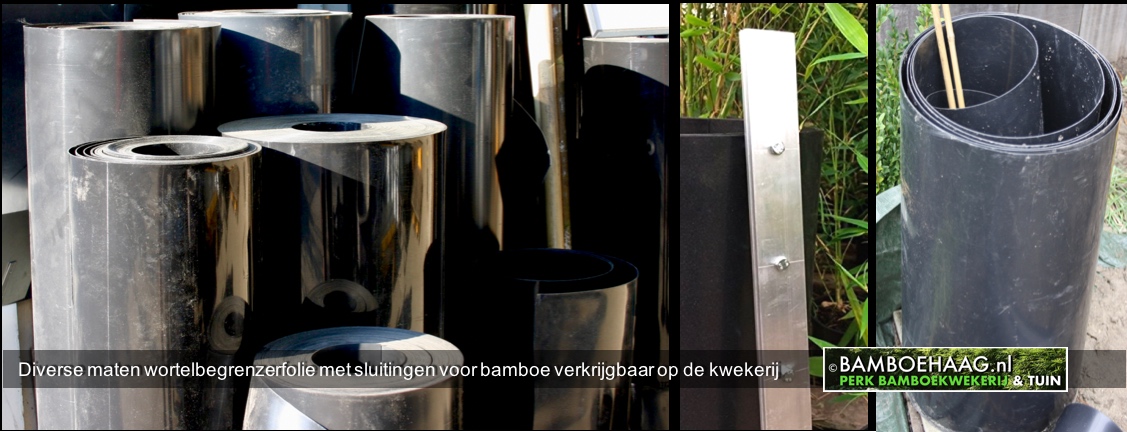
Managing running bamboos
6- Most other species of bamboos (Phyllostachys, Bashania, Indocalamus, Sasa, Pleioblastus, Pseudosasa, Semiarundinaria etc) produce rhizomes that can run away from the plant to a greater or lesser extent. In places with limited growing space, such as many private gardens, it is therefore advisable to apply these species within an underground enclosure with Rhizoom barrierer. This special material, together with the necessary fastener and clear instructions, is available at the nursery in various sizes between 60 and 100 cm high. Depending on the chosen species, available growing space and soil type, we recommend a certain size.
Inatalling the rhizome barrier
7- The planting zone is dug out to the required depth and provided with the root control bamboo liner along the edges. It is important that this material extends 3 to 5 cm above ground level and that the ends are secured with a steel connecting clamp. At the nursery, all these materials are available in any length, upto 50 m.

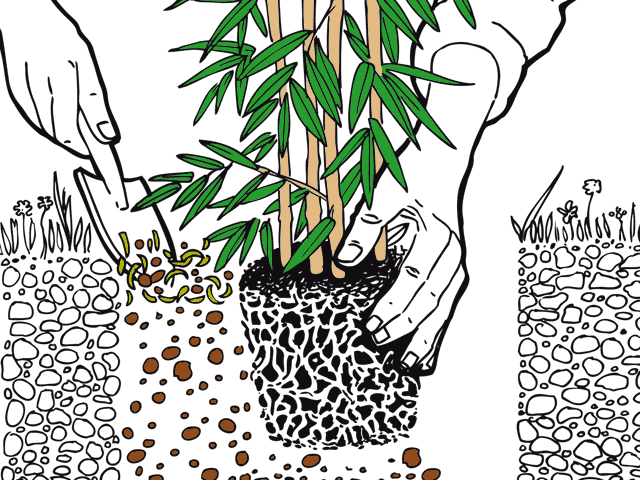
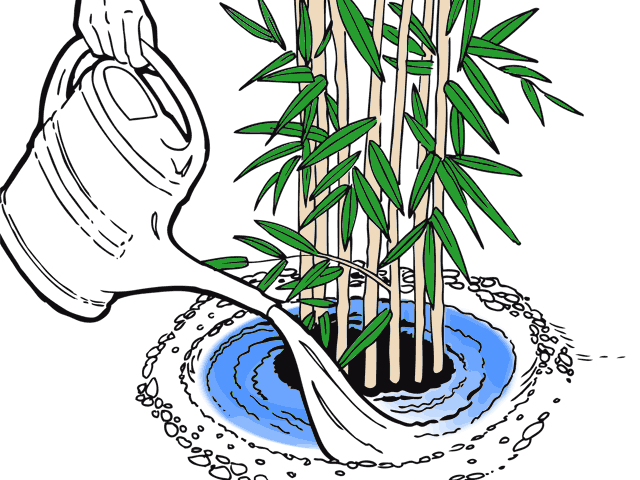
Planting in the garden
8- Submerge the bamboo rootball in a bucket of water for 5-10 minutes until the rootball is saturated, then remove it from the container. If the rootball is very solid, it is wise to use a nail or knitting needle to gently loosen the roots slightly all around so that the rooting in the garden soil proceeds properly. Put the bamboo in the ground at the same level as in the pot, so do not bury it or plant it too high. Fill the space around the root ball with the mix of organic planting substrate from the bag together with the existing soil.
Note. Never use 'fertilized garden soil' or 'compost from domestic organic waste' around the root ball because of the risk of metal salt damage to the hair roots!

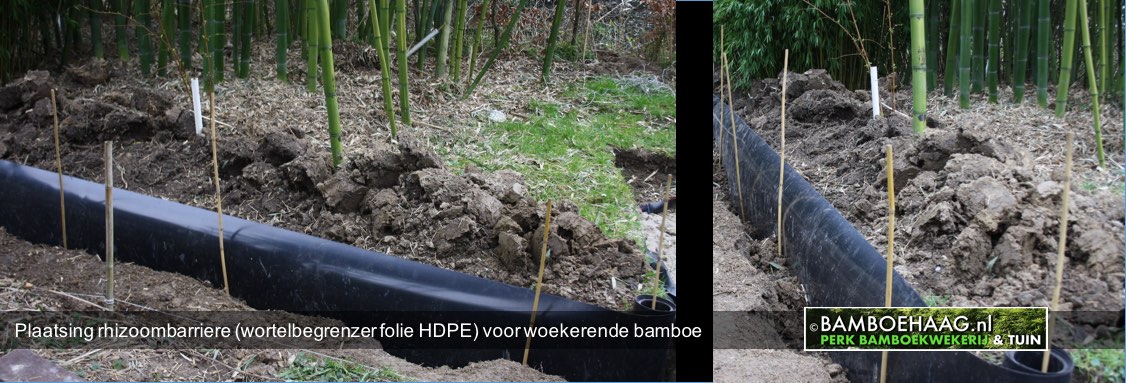
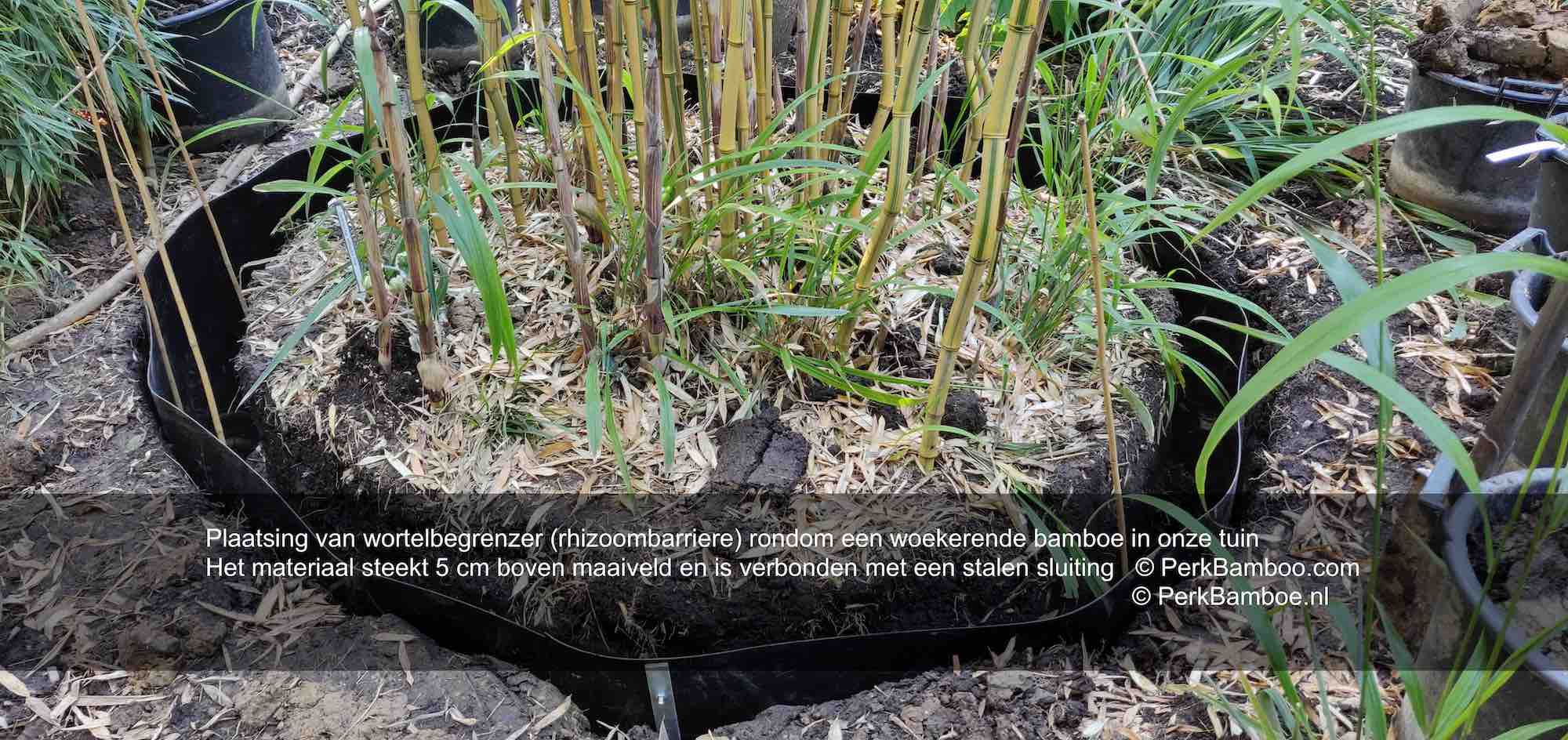
Fertilizing and watering
9- Then water the young plant well, that is, slowly saturate the soil with water using a water hose. To make watering easier, it is useful to make a soil ring around the plant about 5 cm high so that the rain/poured water penetrates into the soil at the roots.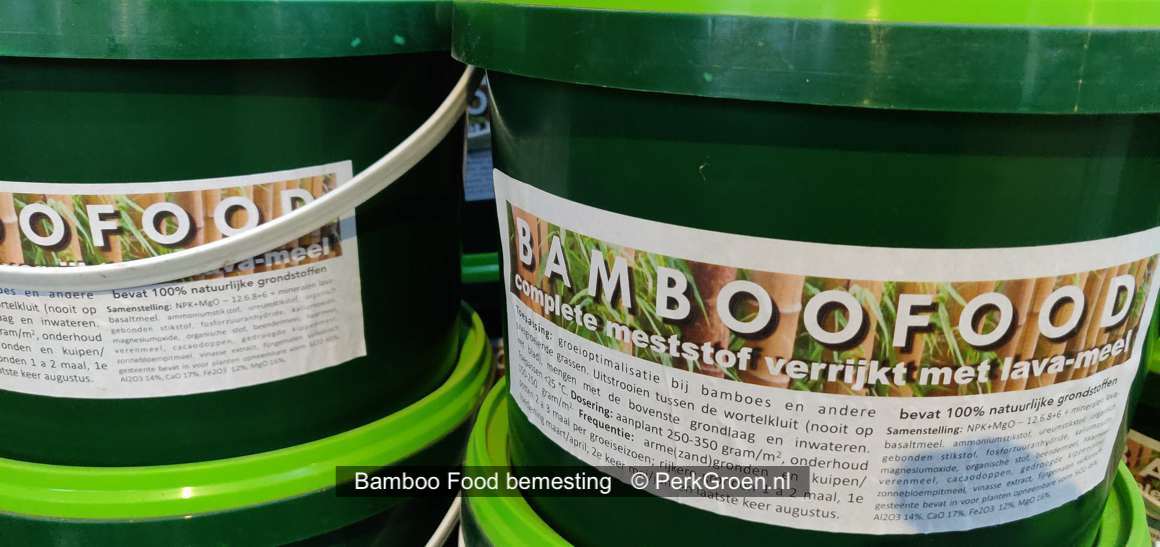
10- Then add bamboo fertilizer to the plants (between March and September, below 25 deg C see label) and water again lightly. BambooFood is available at the nursery in lockable buckets.
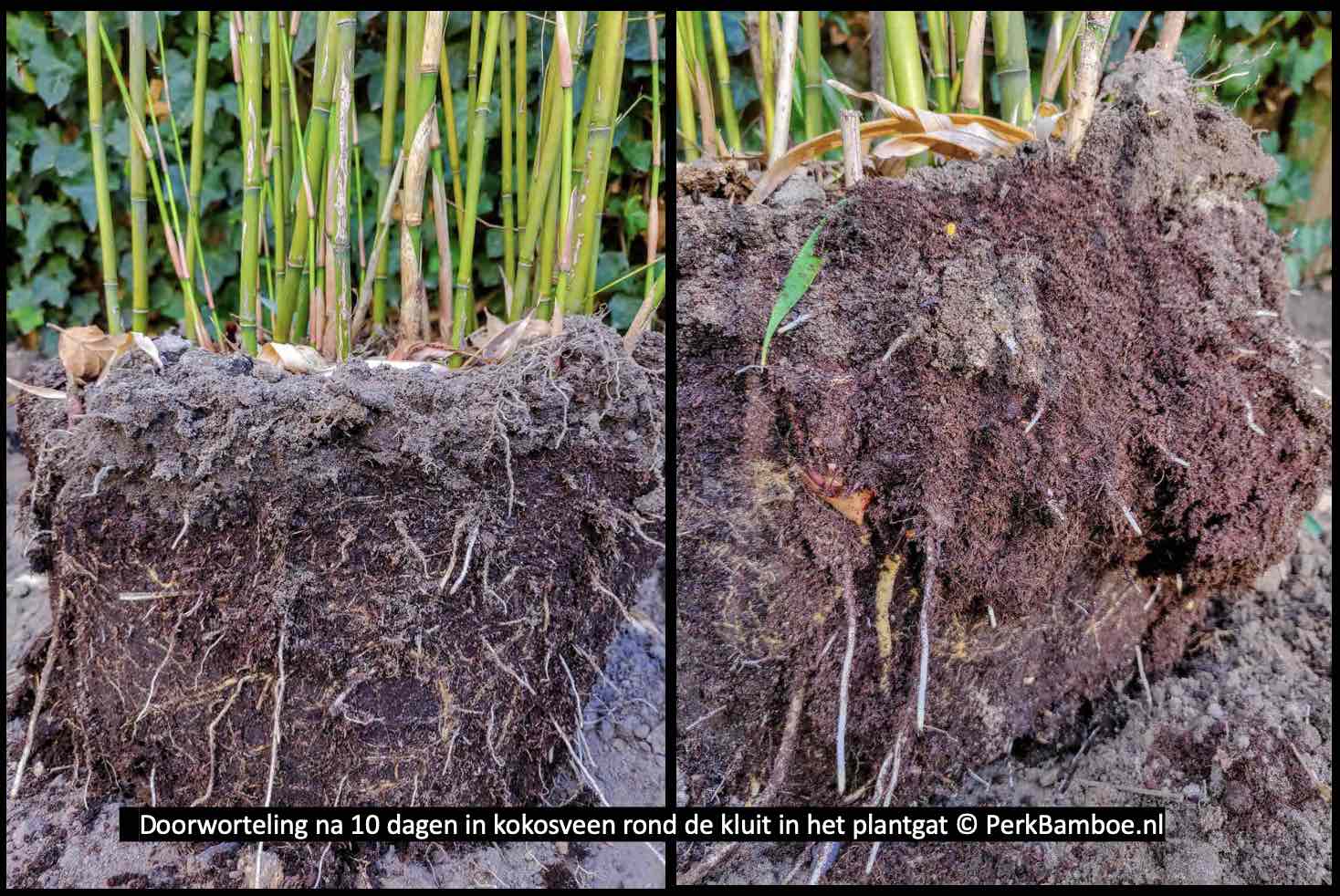
Finishing with mulch layer
11- Finally, it is advisable to cover the planting zone with preferably an organic mulch layer of 3 - 5 cm, for example wood chips or bark. At the nursery we have French Bark in stock. one package is enough for 1-1,5 m2. Finishing with gravel is also possible if desired. In all cases it is important that the edge of the root barrier remains in sight.

Support after planting
Many bamboo species are in mature condition, sturdy and upright. Young plantings will sometimes sag in the tops of the still thin culms due to the weight of the leaves.
It is best to support the bamboo plants after planting along the top by loosely tying the plants up along a wire/tape between two poles with the black binding tube (available at the nursery).
Over time, the bamboo strengthens itself by creating a solid palisade with new (thicker) culms, then the ribbon can be removed.
Environment and recycling
We can reuse the containers in which we grow the plants. You are welcome to return the empty pots from the nursery (only our own pots), or put one in front of the fence. Preferably clean and sorted by size. If the trip is too far for you please consider the local (potting) garden club or drop them off at the recycling plastics at your local recycling center. Wooden pallets lend themselves to making chairs, benches and tables, but may also be returned if in usable condition. Other packaging materials can go with the recyclable packaging waste in your community.
Annual maintenance
During the first growing season, water the young plantings regularly through-and-through (saturating). It is better to slowly saturate the soil with a water hose than to spray remotely on the foliage. Check that the soil remains sufficiently moist. If it starts to dry out, water again until the plants are well established.
For rhizomatous bamboo, check the edges of the root barrier annually for any overgrown roots. These can then be cut off in time to keep the plant in place.
Long-term management and maintenance.
After this first season, there is generally no additional care beyond annual feeding and watering during prolonged drought conditions, especially during new shoot growth between April - July. Depending on the desired outcome, hedges may require annual pruning in height and/or width. This is best done during the growing season after the shoot period of the particular species.
Bamboos planted for the ornamental value of the culms are thinned and pruned annually or every few years. A good ratio is to prune 1/3 of the total height. Old, crooked and thin culms are cut short to the ground to create an airy, rhythmic structure.
Enjoy your bamboo planting! For more questions and information consult www.bamboehaag.nl or www.PerkBamboe.nl. English: www.PerkBamboo.com
Bamboo accessoires
The following accessoires are available at the nursery:
- Bamboo substrate (special planting soil tailored to bamboo cultivation 70L) + hydro grains 40L for application of bamboo in planters
- Various types and sizes of planters
- Bio planting soil - planting hole improver 40L
- Bamboo fertilizer (BambooFood) in buckets 3 kg
- French (maritime pine) bark as mulch layer 40L
- Rhizoom barrier HDPE 35-60-75-100cm high per running meter or full roll 50m + galvanized steel connecting clamps
- Raadplegingen: 673


